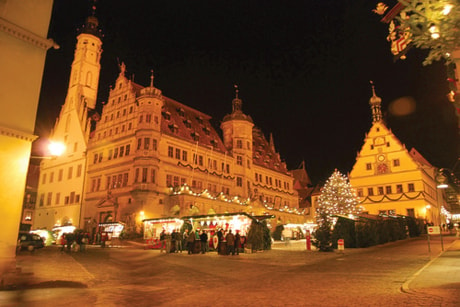ROTHENBURG OB DER TAUBER, Germany — The run-up to Dec. 25 in Germany is marked not just by a rush of shopping, but also by the nation’s many convivial Christmas markets.
While the most renowned are the massive markets in Dresden and Nuremberg, many find the season is best celebrated at the dozens of smaller markets across the nation, like the one in Rothenburg ob der Tauber.
Here, locals and visitors pack the central Reiterlesmarkt square to enjoy the intimate nature of the quaint town.
Surrounded by medieval walls that date back to the 12th century, Rothenburg is also home to Kaethe Wohlfahrt, makers of ornaments and wooden carvings that are popular year-round with tourists, but that really grab attention in the Christmas season.
A couple of hours southwest of Rothenburg, visitors to Esslingen have the choice of visiting either a modern or a medieval Christmas market — which takes all the fantasy of medieval dress, customs, traditions and food and places it in a market atmosphere.
Steffi Fasora, dressed in a blue robe, invited children to play a game with a live mouse that is set down in the middle of a ring of wooden boxes, each of which is claimed by a child.The rodent, dubbed a “magical mouse from India,” ducks into one of the boxes, making that child the winner.
Bringing joy into Germany is what Christmas markets are all about, said Fasora, who works at medieval markets across the region.
Decembers are dark and gloomy, “and people are usually sitting in the house and being depressed,” she said. “That is why we set up a Christmas market — to bring the people out here, to have fun, to meet each other, to spend their money of course!”
A couple of stalls down, bakers baked bread sticks in a wood-burning oven, while a shoemaker sewed together his wares. A bagpiper in a long brown robe strolled around and children made hand-dipped candles.
A six-metre-high Ferris wheel, which two burly men turned by hand, attracted Roberta Morrissey’s children, aged 12, 9 and 6 — all having the time of their lives.
An hour northwest of Esslingen by train, the Heidelberg market is set up in several spots along the city’s 1.6-kilometre-long pedestrian street through the heart of the old city. At one end, skaters glide on a rink below the ruins of the city’s castle, built in the 1200s.
In Konstanz, on the Swiss border, the twinkling lights of the Christmas market stretch through the heart of downtown to the shores of Lake Constance, where a “Christmas Boat” floated with crafted items for sale.
Regional fish were stuffed into rolls, an alternative to to the ubiquitous bratwurst sausages on grills.
Among the hundreds of visitors who packed the fair on a recent Saturday was the Fuellsack family, out for an annual tradition of drinking “Gluehwein,” or hot, mulled wine with hints of citrus and nutmeg.
Katharina, 16, and her sisters joined her parents for an evening at the market. “We go in the evening, because in the evening it’s the prettiest,” she said. There are lots of treats that you can only get at Christmas time, she said, like roasted chestnuts — something she and her sisters love.
You can’t help but be happy at a Christmas market, Katharina said.
Germany’s Christmas markets: http://tinyurl.com/5c9n9d. This is a list, in English, of Germany’s different Christmas markets and what they feature, compiled by Germany’s tourism office.
Esslingen am Neckar: http://tinyurl.com/yzcrtbx offers details on the Esslingen medieval and traditional Christmas markets.
Rothenburg ob der Tauber: http://tinyurl.com/yb5ptjo lists contacts and other information for visiting the city on its website.
Heidelberg: http://tinyurl.com/ygfmxzq offers information about the city for visitors.
Konstanz: http://www.konstanz.de/en/index.html has tourism information in English for visitors.
Getting there: Frankfurt International Airport is in central Germany, and Germany’s railway system connects to all of these cities. Railway fares are quite reasonable, and the main train station in each of the four cities is within walking distance of the markets. Rental cars are also an option, and parking options are well-marked in each city.
